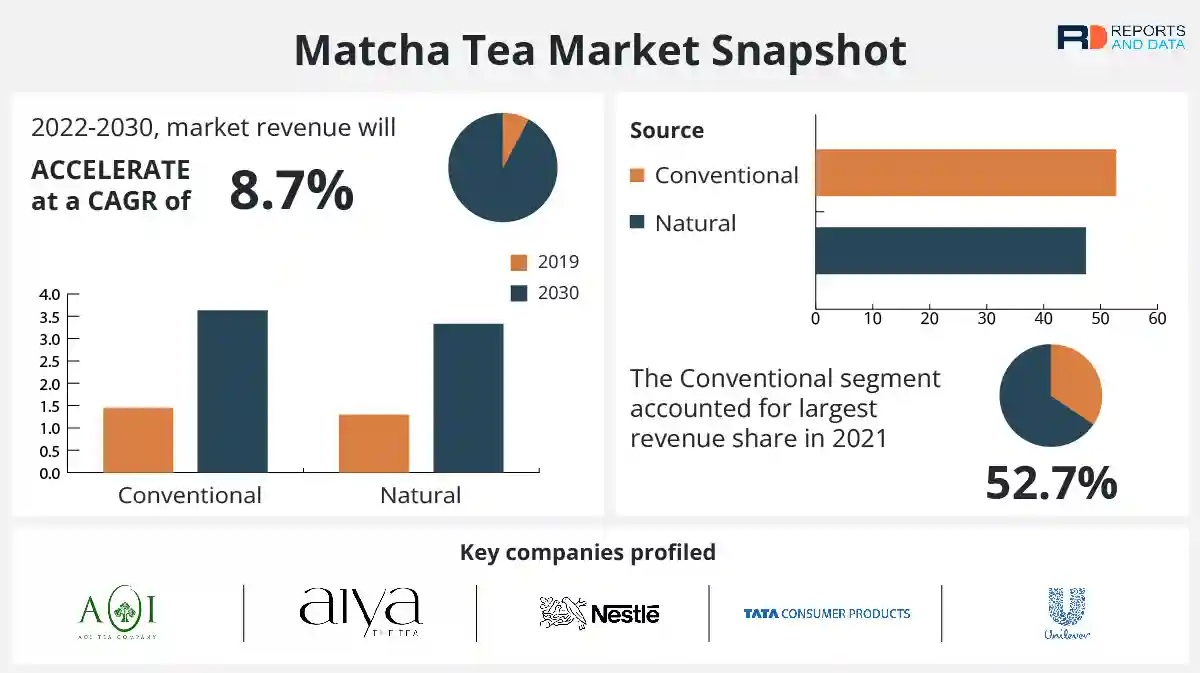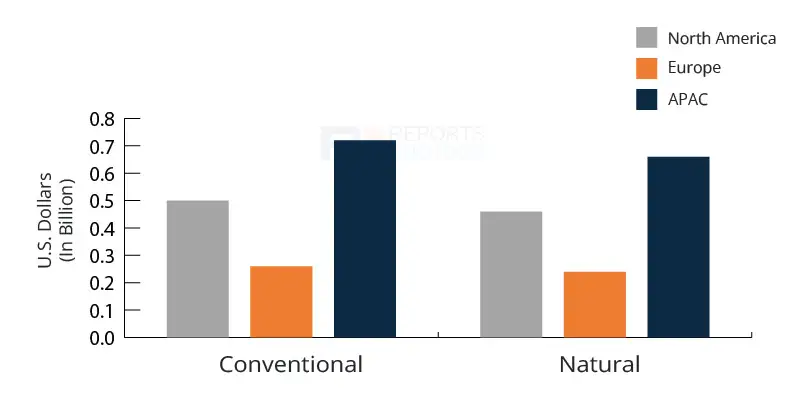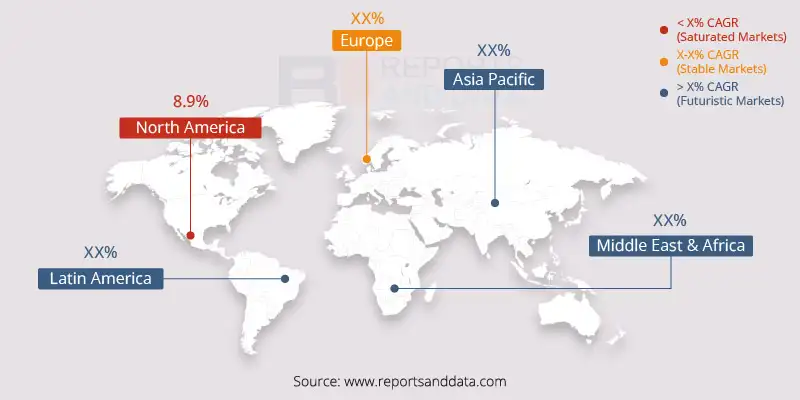Want to curate the report according to your business needs
Report Description + Table of Content + Company Profiles

The global matcha tea market size was USD 3.27 Billion in 2021 and is expected to register a revenue CAGR of 8.7% during the forecast period. Increasing awareness about the health benefits of matcha tea and rising demand for nutrient-rich, healthy beverages which contain Vitamins and antioxidants, along with the unique flavor that this type of tea can add to various foods are the primary factors driving revenue growth of the matcha tea market.
Matcha tea is high in antioxidants and vitamins, and demand is expected to increase owing to rising awareness regarding the benefits among an expanding base of health-conscious consumers. Furthermore, market growth is expected to be supported by rising demand for nutrient-dense, organic, and natural products. Demand is more among health-conscious customers and tea connoisseurs are expected to rise quickly, propelling market revenue growth throughout the projected period. For instance, Tea Drops, a producer of bag-free tea blends, completed a USD 5 million Series A investment round in 2021, with BrandProject serving as the round's lead investor alongside Siddhi Capital and other current investors. A total of USD 8.4 million have been raised through Tea Drops to date. In the U.K., sales of beverages with matcha Flavors have surged by 202%, while ice creams, smoothies, and tea smoothies are all steadily gaining popularity in the U.S.

Moreover, matcha is an excellent source of antioxidants, which effectively lowers inflammation and calms inflamed skin. Epigallocatechin Gallate (ECGC), a potent compound that reduces and counteracts oxidative stress in the skin and can hasten cellular aging, is present in substantial amounts in this grade of tea. When applied topically, it helps the body absorb caffeine, which over time improves skin firmness. Furthermore, the methylxanthines promote microcirculation, providing healthy skin and improving complexion. Polyphenols also protect against Ultraviolet (UV) rays and environmental degradation. Such health benefits of matcha tea are contributing to the revenue growth of this market.
Increasing health and wellness awareness among consumers globally has been a major factor driving revenue growth of the matcha tea market. Matcha tea has several health benefits. It helps in increasing metabolism and calorie burning, detoxifies the skin, calms the mind, and relaxes the body. It also lowers blood sugar and cholesterol, which lowers the risk of heart disease. As per the American Heart Association (AHA), about half of all adults in the U.S. suffer from heart illness. Dietary beverages reduce the risk of heart attack, type 2 diabetes, obesity, and stroke. This grade of tea is very much popular among skin-conscious millennials and generation Z population as they often face acne problems, especially during puberty or adolescence. Antiandrogenic properties of ECGC help to lower stress and regulate androgen hormones, and acne outbreaks can be controlled. According to research, L-theanine gives matcha tea it’s mellow high (an amino acid). The amino acid may aid in enhancing brain function and easing anxiety symptoms. The tea's L-theanine and caffeine also have the potential to enhance focus, alertness, and memory. Thermogenesis (the body's rate of burning calories) can be increased by matcha powder, increasing it from 8% to 10%
Matcha is also used in a variety of beverages and sweets, including lattes, frappés, waffles, green tea ice cream, cupcakes, cookies, and a variety of other treats. The rising demand, however, is for matcha tea and lattes, since weight watchers and health-oriented customers are steadily reducing consumption of sugary treats. Consumers’ shifting preference towards plant-based, healthy beverages along with increasing impact of social media where fitness-based products are advertised and promoted across the globe also contributes to the revenue growth of the matcha tea market.
Many diseases could be prevented or treated by foods and dietary components, but enough research and study are not being done to identify helpful compounds and verify their safety and effectiveness. The ability to conduct such research is largely dependent on adequate regulations. Major food & beverage businesses want to grow into health-promoting foods, but there is little reason to invest in real research when items can be successfully promoted based on vague references alone. This practice sometimes proves to be very harmful to consumers. Slow Research and Development (R&D) activities with limited funding and capital are restricting market revenue growth.
Based on product, the matcha tea market is segmented into powder, RTD beverage, and instant premixes. The powder segment is expected to account for a major revenue share over the forecast period. Various teas have the potential to strengthen the immune system, reduce inflammation, and even stave off cancer and heart disease, according to numerous studies. There is ample proof that regularly consuming tea can have a positive impact on health, even though some varieties offer more health benefits than others. The powdered form of tea is one of the most traditional forms of tea which provides various health benefits, which is eventually resulting in revenue growth for this segment.
Based on grade type, the matcha tea market is segmented into classic, ceremonial, café, culinary, and others. The classic segment is expected to account for a significant revenue share over the forecast period. Factors such as mild fresh flavor of these products, and rising consumption among regular tea drinkers, and new users, the classic grade group is developing, which in turn is driving this segment's revenue growth. As it has a milder, more delicate flavor than culinary matcha, it should be enjoyed on its own rather than with lattes and other desserts. In addition, the classic grade's adaptability makes it simple to add to a variety of foods and beverages, which is expected to spur market revenue growth. The delicate flavor and rich nutritional content of this grade of tea were created especially for use in traditional Japanese tea rituals. In the upcoming years, the economy will continue to be supported by the sales of packaged food products such as savory snacks, drinks, and baked goods. The unique flavor and anti-inflammatory properties of this type of tea are also encouraging its use in diverse culinary preparations. As a result, culinary grade matcha is expected to overtake other grades in popularity.
Based on source, the matcha tea market is segmented into natural, and conventional. The natural segment is expected to account for the largest revenue share over the forecast period owing to rising demand for natural and organic, healthy beverages. The organic grade is said to have more flavors and nutrients than non-organic. The authenticity of food items is maintained by organic ingredients since they do not include pesticides or preservatives. As the market for natural products expands, organic matcha sales continue to increase during the projected timeframe. Customers are also growing more popular with drinks that are nourishing, including vitamins, and give the body energy, increasing awareness of their well-being. As a result, it is estimated that the demand for organic matcha tea would exceed that of its rival throughout the course of the projected period.

Based on regional analysis, the matcha tea market in Asia Pacific accounted for the largest revenue share in 2021. The robust revenue share is primarily driven by high consumption of matcha tea in countries such as Japan and China. Green tea powder such as matcha is an essential component of many Japanese recipes, particularly those used in sweets, including pudding, cakes, cookies, sweet rolls, mochi, chocolate, biscuits, and ice cream. Increasing population and awareness about healthy foods are factors driving sales in countries such as India, Singapore, and Australia, and the trend is expected to increase significantly over the forecast period. The cheap, and easy availability of raw materials is another factor promoting revenue growth in this region. For instance, on March 2022, PerfectTed launched a line of matcha green tea-based natural energy drinks in cans. The drinks from PerfectTed are designed to combat fatigue as the company works to revolutionize more beneficial caffeine intake. PerfectTed claims that its ceremonial grade matcha is single-origin and entirely traceable as it is sourced from Japanese farmers. Matcha is made from Tencha leaves, which have a naturally sweet and mellow flavor. L-Theanine, another component of the plant, controls how much caffeine is absorbed, according to the company, promoting calmness and prolonged focus.
Market in Europe is expected to register a steady revenue growth rate during the forecast period. Rising demand for fortified, nutrient-rich beverages, rising diet and concerns along with changing lifestyles, and prevalence of chronic diseases are encouraging consumers to switch to healthier food and beverage products, and growing awareness of the immunity-enhancing properties of proper diet and food habits are all factors driving the market growth. The presence of key market players in this region who are increasing investments in R&D activities, product launches, and innovations in existing product lines, forming partnership agreements, mergers, and acquisitions are also significantly contributing to the revenue growth of the matcha tea market in this region. For instance, on 22 February 2019, KitKat announced the availability of green matcha tea KitKat bars in a few European countries. The bars were produced in Hamburg, Germany, and distributed throughout the country before being made available in the U.K., Sweden, and Italy. The introduction of KitKat Ruby and KitKat green tea matcha is evidence of the company’s dedication as a top-tier confectionery brand.
Markets in North America are expected to register a moderate revenue growth rate during the forecast period. Rising incidence of Diabetes and obesity is encouraging consumers to focus more on better lifestyles, which is rising the demand for organic and healthy components in North America. For instance, as per the National Diabetes Statistics Report, diabetes affected 34.1 million adults aged 18 and over, or 13% of all adults in the U.S. Presence of major market players in this region is expected to drive revenue growth in the market. Matcha has become increasingly popular when it is added to more food items such as waffles, pancakes, popcorn, and puddings. In addition, owing to revitalizing and health-nourishing properties, there is a rise in demand for beverages with a variety of health advantages, which will support overall product demand. To maintain a healthy lifestyle, consumers in this region have strong preferences for nutritional health drinks. Regarding this, the availability of a wide variety of matcha tea products in the U.S. and Canada is a crucial factor driving expansion of the market.

Competitive landscape of the Matcha tea market is consolidated with a few key players operating on global and regional levels. Key players are engaged in product development and strategic alliances to expand their respective product portfolios and gain a robust footing in the global market. Major players in the market include The AOI Tea Company, Aiya – The Tea, Nestlé, Tata Consumer Products Limited, Unilever, Marukyu Koyamaen, Encha, Hain Celestial, Tenzotea.Co, and Green Foods Corporation.
On 18 January 2022, The Matcha Infused Tea Line, the newest offering from Aiya America, Inc., features three premium Japanese green teas, including Organic Matcha Infused Gyokuro, Sencha, and Genmaicha, providing consumers with a distinctive and pleasurable tea-tasting experience.
This report offers historical data and forecasts revenue growth at a global, regional, and country-level, and provides analysis of the market trends in each of the sub-segments from 2019 to 2030. For this study Reports and Data has segmented the Matcha tea market based on product, grade type, source, and region:
| PARAMETERS | DETAILS |
| The market size value in 2021 | USD 3.27 Billion |
| CAGR (2021 - 2030) | 8.7% |
| The Revenue forecast in 2030 |
USD 6.93 Billion |
| Base year for estimation | 2021 |
| Historical data | 2019-2020 |
| Forecast period | 2022-2030 |
| Quantitative units |
|
| Report coverage | Revenue forecast, company ranking, competitive landscape, growth factors, and trends |
| Segments covered | By Product Outlook, Grade Type Outlook, Source Outlook, Regional Outlook |
| By Product Outlook |
|
| By Grade Type Outlook |
|
| By Source Outlook |
|
| Regional scope | North America; Europe; Asia Pacific; Latin America ; Middle East & Africa |
| Country scope | U.S.; Canada; U.K.; Germany; France; BENELUX; China; India; Japan; South Korea; Brazil; Saudi Arabia; UAE; Turkey |
| Key companies profiled | The AOI Tea Company, Aiya – The Tea, Nestlé, Tata Consumer Products Limited, Unilever, Marukyu Koyamaen, Encha, Hain Celestial, Tenzotea.Co, and Green Foods Corporation. |
| Customization scope | 10 hrs of free customization and expert consultation |
Facing issues finding the exact research to meet your business needs? Let us help you! One of our Research Executives will help you locate the research study that will answer your concerns. Speak to Analyst Request for Customization
Request a FREE Sample here to understand what more we have to offer over competition…
upto20% OFF
upto20% OFF
Want to curate the report according to your business needs
Report Description + Table of Content + Company Profiles
